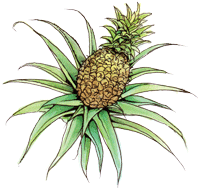Bromelain
ALSO KNOWN AS: Ananase, dayto anase, traumanase.

ALSO KNOWN AS: Ananase, dayto anase, traumanase.
BACKGROUND: An enzyme obtained from the stem and juice of pineapples, bromelain belongs to a group of plant-derived proteolytic enzymes that also includes papain. Bromelain is promoted to treat various inflammation-based disorders. Proteolytic enzymes were first introduced in Europe in the 1960s to treat inflammation, osteoarthritis, autoimmune diseases, and viral infections. Bromelain has since gained popularity in the western hemisphere and is available as a dietary supplement in tablet and capsule form, often in combination with other enzymes.
RESEARCH: Bromelain has potent anti-inflammatory effects[1,2] and has been the focus of research involving inflammatory conditions. Clinical trials show that it is effective in reducing osteoarthritis of the knee[3] and acute sinusitis.[4] Bromelain also has the ability to control edema[5] and support fibrinolysis; in addition, it has been studied for its debriding effects on burn wounds.[6] Bromelain’s mechanisms of action include reduction of prostaglandin E2 and thromboxane levels,[7] inhibition of neutrophil migration in response to interleukin-8,[8] and reduction of secretion of pro-inflammatory chemokines and cytokines.[2]
TAKE HOME POINTS
For additional information, visit the Memorial Sloan-Kettering Cancer Center Integrative Medicine Service website, "About Herbs," at
http://www.mskcc.org/AboutHerbs
.
Several preclinical studies have shown that bromelain has immunomodulatory and antitumor properties.[9,10] However, bromelain’s anticancer potential in humans remains unknown; further studies are needed to determine this. Preliminary data suggest the utility of oral proteolytic enzymes as adjuvants in cancer treatment-for reducing the severity of such radiation therapy side effects as mucositis, skin reactions, and dysphagia in patients with head and neck cancers[11] and for reducing symptoms and side effects associated with the treatment of breast cancer.[12]
ADVERSE REACTIONS: Allergic reactions have been reported.[13]
HERB-DRUG INTERACTIONS: Bromelain inhibits CYP2C9 activity and can affect metabolism of its substrates.[14] Because of its antithrombotic effects, bromelain may increase the risk of bleeding in patients who take anticoagulants.[15] Bromelain can increase the levels of tetracycline in the blood.[16]
References:
REFERENCES
1. Onken JE, Greer PK, Calingaert B, et al. Bromelain treatment decreases secretion of pro-inflammatory cytokines and chemokines by colon biopsies in vitro. Clin Immunol. 2008;126:345-52.
2. Secor ER, Carson WF, Singh A, et al. Oral bromelain attenuates inflammation in an ovalbumin-induced murine model of asthma. Evid Based Complement Alternat Med. 2008;5:61-9.
3. Akhtar NM, Naseer R, Farooqi AZ, et al. Oral enzyme combination versus diclofenac in the treatment of osteoarthritis of the knee--a double-blind prospective randomized study. Clin Rheumatol. 2004;23:410-5. Epub 2004 Jul 24.
4. Braun JM, Schneider B, Beuth HJ. Therapeutic use, efficiency and safety of the proteolytic pineapple enzyme Bromelain-POS in children with acute sinusitis in Germany. In Vivo. 2005;19:417-21.
5. Inchingolo F, Tatullo M, Marrelli M, et al. Clinical trial with bromelain in third molar exodontia. Eur Rev Med Pharmacol Sci. 2010;14:771-4.
6. Rosenberg L, Lapid O, Bogdanov-Berezovsky A, et al. Safety and efficacy of a proteolytic enzyme for enzymatic burn debridement: a preliminary report. Burns. 2004;30:843â50.
7. Maurer HR. Bromelain: biochemistry, pharmacology and medical use. Cell Mol Life Sci. 2001;58:1234-45.
8. Fitzhugh DJ, Shan S, Dewhirst MW, et al. Bromelain treatment decreases neutrophil migration to sites of inflammation. Clin Immunol. 2008;128:66-74.
9. Bhui K, Prasad S, George J, Shukla Y. Bromelain inhibits COX-2 expression by blocking the activation of MAPK regulated NF-kappa B against skin tumor-initiation triggering mitochondrial death pathway. Cancer Lett. 2009;282:167-76.
10. Kalra N, Bhui K, Roy P, et al. Regulation of p53, nuclear factor kappaB and cyclooxygenase-2 expression by bromelain through targeting mitogen-activated protein kinase pathway in mouse skin. Toxicol Appl Pharmacol. 2008;226:30-7.
11. Gujral MS, Patnaik PM, Kaul R, et al. Efficacy of hydrolytic enzymes in preventing radiation therapyâinduced side effects in patients with head and neck cancers. Cancer Chemother Pharmacol. 2001;47 Suppl:S23â8.
12. Beuth J, Ost B, Pakdaman A, et al. Impact of complementary oral enzyme application on the postoperative treatment results of breast cancer patients-results of an epidemiological multicentre retrolective cohort study. Cancer Chemother Pharmacol. 2001;47 Suppl:S45â54.
13. Nettis E, Napoli G, Ferrannini A, Tursi A. IgE-mediated allergy to bromelain. Allergy. 2001;56:257-8.
14. Hidaka M, Nagata M, Kawano Y, et al. Inhibitory effects of fruit juices on cytochrome P450 2C9 activity in vitro. Biosci Biotechnol Biochem. 2008;72:406-11.
15. Metzig C, Grabowska E, Eckert K, et al. Bromelain proteases reduce human platelet aggregation in vitro, adhesion to bovine endothelial cells and thrombus formation in rat vessels in vivo. In Vivo. 1999;13:7-12.
16. Bradbrook IK, Morrison PJ, Rogers HJ. The effect of bromelain on the absorption of orally administered tetracycline. Br J Clin Pharmacol. 1978;6:552â4.